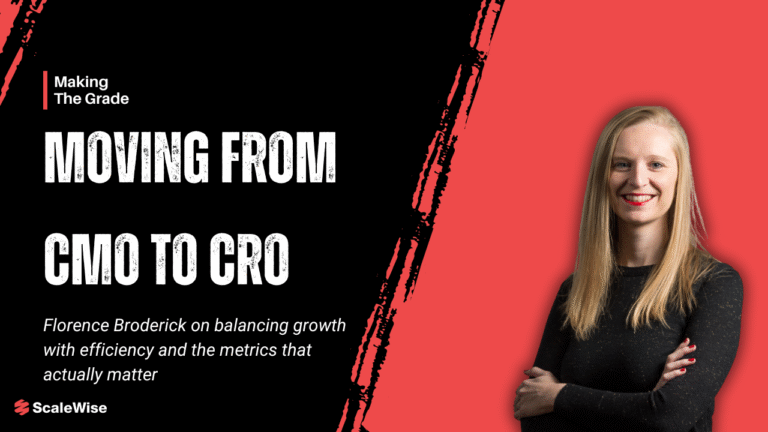Most CROs don’t fail due to a lack of talent. They fail because they’re dropped into misaligned, under‑diagnosed systems with unrealistic expectations. How to solve it: Fix scope, stage‑fit and alignment first; consider a fractional or interim path to diagnose, stabilise and sequence the work before you hire permanently.
In 2025, the average tenure of a CRO is less than 18 months.
That short window is no coincidence. Across the scaling SaaS / B2B landscape, CROs are often set up to fail. Rarely is it a performance issue; the failure is baked in from the start – misalignment, lack of clarity, mandate overload, organisational politics, and unrealistic expectations.
In this article, we’ll unpack the repeatable failure modes that explain why CROs tend to flame out so fast, and offer advice on increasing the odds of longevity for your next hire.
The cost of CRO turnover
It’s not just symbolic; high turnover has real consequences.
- Financial drag: severance packages, recruiting costs, downtime, lost deals.
- Loss of momentum: every transition slows execution, decision-making, and team confidence.
- Trust erosion: internal teams, sales leaders, VPs, and external stakeholders (investors, customers) lose faith.
- Organisational fatigue: frequent leadership change breeds uncertainty and can stunt growth.
On average, replacing a CRO can set you back by £300k+, considering compensation, severance, search fees, onboarding etc. Indirect costs such as deal slippage, slower cycles, lost hires often dwarf that.
Not mentioning the additional amount of time and revenue constraints.
That’s why the decision to let a CRO go after a few months is never made lightly; it’s usually because something critical is missing or is misaligned.
Five failure modes that kill your CRO's tenure
Having seen many CROs come and go, we’ve seen founders make the same mistakes over and over again when it comes to hiring CROs. Here are some of the most common mistakes we see…
1. Poorly scoped role & misaligned expectations from Day 1
Too many companies hire a CRO without a clear diagnostic phase. They expect the incoming revenue leader to “just fix it”, but no one has mapped out what that actually looks like, how progress will be measured or what success should look like at this stage.
In effect, the CRO is parachuted into a broken engine, or a business that simply isn’t ready for a CRO yet.
💡 What to do: Work with an experienced GTM operator who can support the role scoping phase and clearly define 2-5 success measures for the first six months.
2. Hiring too early or too late
Bringing in a heavyweight CRO before product-market fit or foundational GTM clarity means they have limited levers to pull. Essentially, they’re asked to scale a business that doesn’t have GTM foundations in place yet.
On the other hand, waiting too long and bringing in a CRO only when GTM chaos has metastasised means the CRO is expected to rescue and transform simultaneously.
In both cases, the underlying structural issues slow down or block performance.
💡 What to do: If Product-Market-Fit is shaky, start with fractional GTM support to help you stabilise your ICP, motion and pipeline, before scaling further.
3. Leadership & Board misalignment
Even the best CRO will struggle if the founder or board have a different mental model. Misalignment over priorities, KPIs, sales model, or even how aggressive to be with investment can sink a CRO.
We often see CRO’s being let go, not because the performance wasn’t there, but because the rest of the leadership team didn’t align their expectations.
💡 What to do: Align your CEO and Board on 3-4 north-star metrics (e.g. NRR, CAC payback, etc.) and clear ownership between Sales, Customer Service and RevOps.
4. Overreliance on “Playbook Hires”
It’s tempting to hire a CRO based on pedigree and shiny logos on their CVs. But scaling at Series C or in a large enterprise is fundamentally different from scaling at earlier stages. The playbook that worked at one stage may not translate over.
Very often, the path of CROs can look different from what you might have had in mind. For example, CMOs often make great CROs, even if it’s not a typical step to take. Listen to our interview with Florence Broderick for more on this topic.
You need to decide early on whether you want a hands-on or a management CRO. When you get blinded by shiny logos and ignore stage-fit, your new CRO will struggle, and you will ultimately not get what you need at this crucial stage.
💡 What to do: Hire for stage-fit and decide if you currently need a builder or a manager of managers. Both types can be effective, but they will require a very different scope.
5. Lack of onboarding & support
The hiring process doesn’t stop after making an offer. Many companies adopt a “sink or swim” model for executive hires. But without detailed onboarding, internal sponsorship, clarity, and early support, the ramp is steeper, and the chance of missteps or misperceptions increases.
💡 What to do: Codify a 30-60-90 Day plan with realistic goals and milestones, assign an exec sponsor and define your 30-day wins up front.
Learn more about how to hire the right CRO for your stage in this article.
Full-time vs Fractional CRO - Which path should you choose?
Given the volatility of full-time CRO roles, many companies (especially earlier-stage start-ups) explore fractional or interim CROs. A pragmatic path is to start fractional for diagnosis and alignment, then convert or hire full-time once foundations and cadence are in place.
Here’s how to think about which model is right, and when…
When a fractional CRO makes sense
The Pros:
- Lower risk, lower commitment – try before you buy to ensure culture-fit for the long-term, all with less overhead.
- Faster impact – experienced fractional CROs come with frameworks, diagnostics, and objectivity, which often lets them ramp up much faster than a permanent hire.
- Flexibility – scale up or down their involvement by quarter and funding stage.
- Bridge or specialist mandate – it’s ideal when you need help with a specific area (e.g. GTM design, structuring, pipeline optimisation) rather than full accountability.
The Cautions:
- Scope must be crystal clear – fractional roles that try to cover everything frequently fail, so you need to invest the time up front to really think about the scope and brief for the role.
- The fractional model is a stepping stone, not a long-term substitute – eventually, you’ll want to make a full-time commitment and hire a CRO. Sometimes this could be a fractional leader transitioning into a permanent role <case study link> or a fractional leader helping you scope the role and find the perfect fit, considering they’ve been in the role.
When a full-time CRO is the right bet
You should consider making a full-time when…
- GTM fundamentals are in place – product-market fit is validated, repeatable demand channels exist, and you’re ready to scale.
- The revenue scale and complexity require continuous leadership presence.
- You have the budget, patience, and runway to support the investment.
For even more factors to consider when weighing up a full-time vs fractional CRO, make sure you read our full guide to hiring a CRO.
Choosing the right time & sequence
A smart path is often to start with a fractional or interim CRO to diagnose, align, and stabilise. Then transition (or convert) to full-time when the organisation is ready for the commitment.
But don’t rush it. Many organisations hire a CRO as a “silver bullet” when the underlying systems are not mature enough to support one. That’s often when failure begins.
The truth is, CROs don’t fail because of poor resumes or lack of talent; they fail because companies make them walk into a minefield without a map.
If your business is thinking about hiring a revenue leader, don’t just ask “When can we get a CRO?” — ask “Are we ready for one? What do we want them to fix first?”
Start with clarity, alignment, structure, and patience.
Whether you begin with a fractional CRO to diagnose and stabilise, or go straight to a full-time hire, the same core guardrails apply. Do it right, and maybe your CRO sticks around for years, rather than months.
To find out more about interim and fractional leadership, check out our Definite Guide to Interim and Fractional Leadership.






